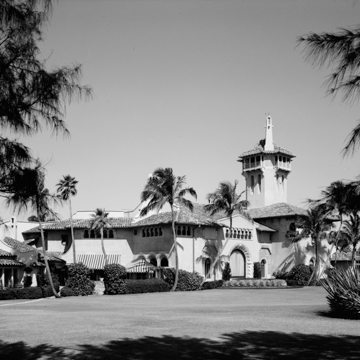First published in The American Architect as the house of Edward F. Hutton in Palm Beach, Mar-a-Lago has always been more complex and interesting than first presented. The house was designed almost exclusively for the General Foods heiress Marjorie Merriweather Post and lamented by Hutton, her then husband. It is most often attributed to Joseph Urban and Marion Sims Wyeth, the latter of whom regretted his role in Mar-a-Lago’s creation. Situated in 1923 on a carefully selected piece of high rock formation with views over Lake Worth and the Atlantic Ocean, the building was planned by Post and Urban as a safe hideaway facing away from the public road in order to protect the wealthiest woman in America and her family. It was, however, also planned as an exuberant stage set for elaborate gatherings that would, in some sense, bring to new heights the spectacle started by Addison Mizner and Paris Singer with the founding of the Everglades Club in Palm Beach in 1919.
In the hands of the Viennese-born Urban, the Spanish Mediterranean Revival architecture—popularized by Mizner and featuring barrel vaulted roofs, loggias, fountains, tiles, metalwork, and arcades—is pulled and pushed into almost Jugendstil confections. Some of the most unusual of these features may be found in the details of the elongated chimneys and in the designs of the fantastical birds and other animals throughout the property created by the sculptor and craftsman Franz Barwig.
The complex has an unusual plan designed to avoid the public appearance of a large house and to provide each function with its own space. Each of the public rooms (except the main dining room) opens on to a semicircular patio that faces a large outdoor lawn. On the south side of the patio is a larger building called the “Owners House,” and spread throughout the property along the patio and into the tower rising above it were numerous bedrooms. The idea of enhancing the visitor experience through a series of architectural set pieces, each with its own character, was established in Palm Beach in the Everglades Club, which, in turn, followed the example of Vizcaya, built in Miami two years prior, in 1917. At Mar-a-Lago, which means “Sea to Lake,” Urban organizes the spaces around the curved patio so that each gets its own special view and orientation reminiscent of the theatrical layout of the imperial palace on the Palatine Hill in Rome. The irregular configuration of the plan, which was designed around the emotional response to space rather than a known set of academic rules, caused the Beaux-Arts–trained Wyeth to withdraw from later associations with the project.
Mar-a-Lago has always been more than just a very large Palm Beach “cottage.” During construction, for example, when the bubble burst on the Florida economy, instead of laying off workers or downsizing the project, Post felt compelled to keep as many workers on as possible through the difficult year of 1926. Before the Great Depression, Mar-a-Lago was an example of a private relief effort for laborers. With the additional work, the cost grew from the original budget of $1 million to a final figure of about $2.5 million.
Four decades later, Post sought a way to preserve both Hillwood—her Washington D.C. residence that is now a public house museum—and Mar-a-Lago. She proposed to Congress that the U. S. Department of the Interior take over the maintenance and upkeep of the building as a residence for special international guests of the United States and as a retreat for American presidents. Mar-a-Lago was documented by the Historic American Buildings Survey in 1967 and was declared a national historic landmark in 1972. By that point, all that stood in the way of realizing Post’s idea was Richard Nixon’s signature on the proposal, adopting the building as the official Winter White House. With Post’s death in 1973 and Nixon’s resignation in 1974, the building was offered to the federal government but without any official status as a winter retreat. In 1980, for reasons related to flight patterns, taxes, maintenance costs, and complaints from the City of Palm Beach, Mar-a-Lago was returned by the federal government to the Post Foundation. Five years later, in 1985, the property was purchased by Donald Trump for $10 million. Post’s proposal has finally been realized—today Mar-a-Lago is used by President Trump as his unofficial Winter White House.
References
Gross, Steve, and Sue Daley. Old Florida: Florida’s Magnificent Homes, Gardens, and Vintage Attractions.New York: Rizzoli, 2003.
Reeves, F. Blair, “Mar-a-Lago,” Palm Beach County, Florida. Historic American Buildings Survey, 1967. Prints and Photographs Division, Library of Congress (HABS-FLA 50-PALM-1).
Rubin, Nancy. American Empress: The Life and Times of Marjorie Merriweather Post. New York: Villard Books, 1995.
Scott, Irvin L. “Maralago.” The American Architect133 (June 20, 1928): 795–811.

